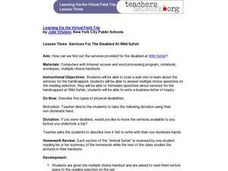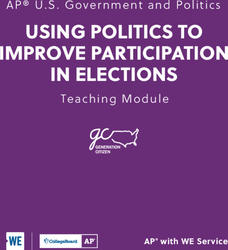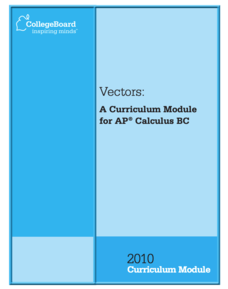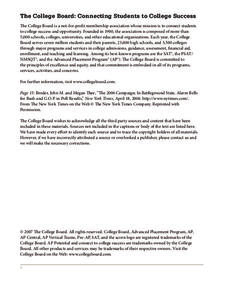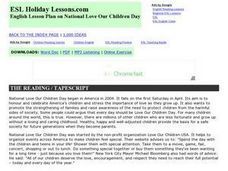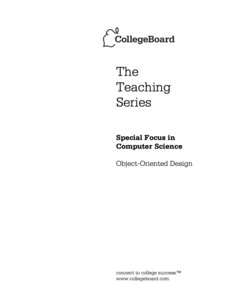Curated OER
Services for the Disabled At Wild Safari
Students discover and enter the website for Six Flags Amusement park. Individually, they identify and discuss the types of services available to the handicapped. After reading the website, they answer comprehension questions and write...
Curated OER
Breaking News English: Vietnam Illegally Logging Laos Forests
In this English worksheet, students read "Vietnam Illegally Logging Laos Forests," and then respond to 2 graphic organizers, 47 fill in the blanks, 7 short answers, 20 matching, and 8 true or false questions about the...
College Board
Using Politics to Improve Participation in Elections
Instructors new to teaching AP U.S. Government and Politics classes, as well as seasoned veterans, will find this teaching guide an invaluable resource. Using a project-based approach to civics education, the lessons emphasize real-world...
The New York Times
Super Brand
Children can recognize popular brands from an early age, but these images symbolize much more than what they advertise. Take a journey through the design of a logo with a lesson that focuses on the history and ubiquity of the Super Bowl...
Curated OER
Community Foundations and Procedure
Students understand what a community foundation is and how it gets input from the community. In this community foundation instructional activity, students form an advisory board to give suggestions. Students learn procedures to hold...
Curated OER
What Is a Foundation?
Students explore the concept of grants. In this philanthropy lesson, students meet a grant-writer and then collaborate to prepare a grant request.
Curated OER
Be Screen Free for a Week
Challenge yourself to completely close all of your electronic screens for seven straight days!
Curated OER
Uncle Jed's Barbershop
Fourth graders examine productive resources. In this economics lesson, 4th graders read a book about a man who saves money to buy his own barbershop. After reading, students get into groups to play a game to learn about savings.
Curated OER
Discovering pi
Tenth graders investigate the history of Pi and how it relates to circles. In this geometry lesson, 10th graders measure the circumference of a circle and the diameter of a circle. They relate these measurements to the number of Pi or 3.14
Curated OER
What Floats Your Boat?
Students explore the principles of buoyancy and Archimedes' Principle and design their own flotation device. They compare the dimensions of a model to the real object to determine scale and analyze the models to suggest improvements.
Curated OER
The Federal Reserve
Young scholars explore the role of government in the economy market. In this economics lesson, students analyze the decision making and how it takes into consideration additional cost, benefits and public awareness of what they are...
College Board
Vectors: A Curriculum Module for AP® Calculus BC
It is all in a matter of time. The model curriculum module uses parametric equations and vectors to solve problems dealing with particle motion along a curve. At the beginning of the lesson, the unit reviews parametric equations and...
College Board
Sampling Distributions
The validity of data depends on the strength of the sample. A collection of instruction and activities focuses on sampling distributions and the analysis of that data. Scholars learn about distribution tests such and Central Limit...
Curated OER
National Love Our Children Day
Have your class discuss National Love Our Children Day worksheet. Learners complete activities, such as reading a passage, matching phrases, filling in the blanks, choosing the correct word, spelling, sequencing, asking questions,...
Curated OER
International Children's Book Day
Celebrate International Children's Book Day using this resource. Learners complete activities, such as reading a passage, sequencing, unscrambling sentences, writing questions, conducting surveys, and writing. Students complete twelve...
College Board
Balance of Power Between Congress and the President
Three branches of government help create a system of checks and balances. A helpful resource provides a series of articles regarding the balance of power between the legislative and executive branches of government. Historians answer...
Wish for the Future
Wish for the Future
What would be your class's ideal world 30 years in the future? What about 100 years? Use a series of activities to discuss globalization, sustainability, scientific contributions to society, and the global community of which your...
College Board
Object-Oriented Design
Just jump in with both feet. To better teach Java, one must think Java. The College Board built document immerses teachers in object-oriented design by providing several resources for use. Resources include teaching strategies, design...
College Board
Special Focus: Inference
Statistics is all about making inferences! A lesson guide explains the meaning of inferences and how to use statistics to make them. The resource provides instruction as well as information about the topic on the AP® Statistics exam.
College Board
Extrema
No need to go to extreme lengths to find resources on extrema. The central focus of an AP® curriculum module is on critical points and extrema, and how to cover these concepts throughout the course. A set of three worksheets helps assess...
Curated OER
Money, Commercial Banking, and Interest
Stdents explore the operation of the commercial banking system and the mechanics of money creation through the lending process. They investigate various interest rates to develop the relationship between interest rates and risk and...
Curated OER
Philanthropists: Past, Present, Future
Learners explore the concept of philanthropy. In this philanthropy lesson, students compare the work of antislavery activists to work of philanthropic activists today. Student implement a plan to share kindness with others.
Curated OER
Inside Money
Young scholars watch a video of a fictional country that is facing monetary problems. They work to answer questions that help solve the countries economic difficulties.
Curated OER
Money, Money, Honey Bunny!
Students determine the differences between goods and services, and saving and spending. In this economics lesson, students listen to a rhyming story about a bunny with money. They play a matching game with the associated cards and work...
